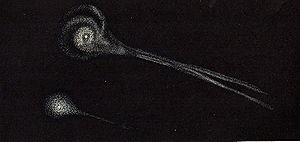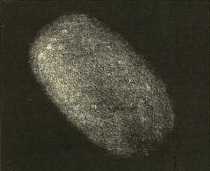Lost comet

A lost comet is one which was not detected during its most recent perihelion passage. This generally happens when data is insufficient to reliably calculate the comet's location or if the solar elongation is unfavorable near perihelion passage. The D/ designation is used for a periodic comet that no longer exists or is deemed to have disappeared.[1]
Lost comets can be compared to lost asteroids (lost minor planets), although calculation of comet orbits differs because of nongravitational forces, such as emission of jets of gas from the nucleus. Some astronomers have specialized in this area, such as Brian G. Marsden, who successfully predicted the 1992 return of the once-lost periodic comet Swift–Tuttle.
Overview

Loss
There are a number of reasons why a comet might be missed by astronomers during subsequent apparitions. Firstly, cometary orbits may be perturbed by interaction with the giant planets, such as Jupiter. This, along with nongravitational forces, can result in changes to the date of perihelion. Alternatively, it is possible that the interaction of the planets with a comet can move its orbit too far from the Earth to be seen or even eject it from the Solar System, as is believed to have happened in the case of Lexell's Comet. As some comets periodically undergo "outbursts" or flares in brightness, it may be possible for an intrinsically faint comet to be discovered during an outburst and subsequently lost.
Comets can also run out of volatiles. Eventually most of the volatile material contained in a comet nucleus evaporates away, and the comet becomes a small, dark, inert lump of rock or rubble,[2] an extinct comet that can resemble an asteroid (see Comets § Fate of comets). This may have occurred in the case of 5D/Brorsen, which was considered by Marsden to have probably "faded out of existence" in the late 19th century.[3]

Comets are in some cases known to have disintegrated during their perihelion passage, or at other points during their orbit. The best-known example is Biela's Comet, which was observed to split into two components before disappearing after its 1852 apparition. In modern times 73P/Schwassmann–Wachmann has been observed in the process of breaking up.
Recovery
Occasionally, the discovery of an object turns out to be a rediscovery of a previously lost object, which can be determined by calculating its orbit and matching calculated positions with the previously recorded positions. In the case of lost comets this is especially tricky. For example, the comet 177P/Barnard (also P/2006 M3), discovered by Edward Emerson Barnard on June 24, 1889, was rediscovered after 116 years in 2006.[4]
Long period comets
Comets can be gone but not considered lost, even though they may not be expected back for hundreds or even thousands of years. With more powerful telescopes it has become possible to observe comets for longer periods of time after perihelion. For example, Comet Hale–Bopp was observable with the naked eye about 18 months after its approach in 1997,[5] and the James Webb Space Telescope observed Hale–Bopp in 2022, 25 years since last approach, when it was 46.2 AU from the Sun.[6]
Comets that have been lost or which have disappeared have names beginning with a D, according to current naming conventions.
List
Comets are typically observed on a periodic return. When they do not they are sometimes found again, while other times they may break up into fragments. These fragments can sometimes be further observed, but the comet is no longer expected to return. Other times a comet will not be considered lost until it does not appear at a predicted time. Comets may also collide with another object, such as Comet Shoemaker–Levy 9, which collided with Jupiter in 1994.
| Name(s) | Initially discovered | Period (years) | Last seen | Recovered | Fate |
|---|---|---|---|---|---|
| D/1770 L1 (Lexell) | 1770 | 5.6 | Probably lost due to a 1779 close encounter with Jupiter which might have greatly perturbed the orbit or even ejected the comet from the Solar System. The asteroid (529688) 2010 JL33 is most likely its inert remnant. | ||
| 3D/Biela | 1772 | 6.6 | 1852 | Broke up in two fragments (1846), then thousands, creating the Andromedids meteor shower | |
| 27P/Crommelin | 1818 | 27.9 | 1873 | 1928 | Three independent discoveries linked by Crommelin in 1930 |
| 289P/Blanpain | 1819 | 5.2 | 2003 | Lost since 1819 discovery due to faintness; rediscovered in 2003 thanks to good viewing conditions; first identified as asteroid 2003 WY25, subsequently matched to the 1819 comet after 184 years and 35 orbits; confirmed by observations in 2013 and 2014 near perihelion; probable source of the Phoenicids meteor shower observed since 1956 | |
| 273P/Pons–Gambart | 1827 | 180 | 2012 | Period of roughly 64±10 years originally computed in 1917 was wrong; rediscovered after 185 years in a single orbit; possibly matches a Chinese observation in 1110 | |
| 54P/de Vico–Swift–NEAT | 1844 | 7.3 | 1894, 1965 | 2002 | Lost several times due to perturbations by Jupiter |
| 122P/de Vico | 1846 | 74.4 | 1995 | Not observed on first predicted return in 1921; recovered in 1995 after 149 years and 2 orbits | |
| 5D/Brorsen | 1846 | 5.5 | 1879 | Lost since 1879 despite good orbit computations | |
| 80P/Peters–Hartley | 1846 | 8.1 | 1982 | Recovered in 1982 after 136 years and 17 orbits; regularly observed since then | |
| 20D/Westphal | 1852 | 61.9 | 1913 | Expected in 1976 but not observed; next possible return in 2038 | |
| 109P/Swift–Tuttle | 1862 | 133.3 | 1992 | Recovered after 130 years as predicted in 1971 by Brian G. Marsden; retroactively matched to observations of 1737 in Europe and 188 AD and 68 BC in China; source of the Perseids meteor shower | |
| 55P/Tempel–Tuttle | 1865 | 33.2 | 1965 | Recovered in 1965 after 99 years and 3 orbits; matches earlier observations of 1366 and 1699; source of the Leonids meteor shower | |
| 11P/Tempel–Swift–LINEAR | 1869 | 6.4 | 1908 | 2001 | Recovered in 2001 after 93 years and 15 orbits; not observed in 2008 due to solar conjunction but seen again in 2014 as predicted |
| 72P/Denning–Fujikawa | 1881 | 9.0 | 1978 | 2014 | Recovered in 1978 after 97 years and 11 orbits, then lost again and recovered in 2014 after 4 more orbits |
| 15P/Finlay | 1886 | 6.5 | 1926 | 1953 | Regularly observed since 1953 |
| 177P/Barnard | 1889 | 118.8 | 2006 | Recovered after 117 years[4] in a single orbit | |
| 206P/Barnard–Boattini | 1892 | 5.8 | 2008 | Recovered in 2008 after 116 years and 20 orbits; not seen on predicted return in 2014; next perihelion in 2021 | |
| 17P/Holmes | 1892 | 6.9 | 1906 | 1964 | Regularly observed since 1964; large outburst in 2007 |
| 205P/Giacobini (D/1896 R2) | 1896 | 6.7 | 2008 | Recovered in 2008 after 112 years and 17 orbits; seen in 2015 as predicted; three visible fragments | |
| 18D/Perrine–Mrkos | 1896 | 6.75 | 1909, 1968 | 1955 | Lost after 1909, recovered in 1955 and lost again since 1968 |
| 113P/Spitaler | 1890 | 7.1 | 1993 | Recovered in 1993 after 103 years and 15 orbits; regularly observed since 1994 perihelion | |
| 97P/Metcalf–Brewington | 1906 | 10.5 | 1991 | Recovered in 1991 after 84 years and 11 orbits; orbital period lengthened by Jupiter in 1993 | |
| 69P/Taylor | 1915 | 6.95 | 1976 | Recovered in 1976 after 61 years and 9 orbits; regularly observed since 1977 perihelion | |
| 25D/Neujmin | 1916 | 5.4 | 1927 | Only seen twice; lost since 1927 | |
| 34D/Gale | 1927 | 11.0 | 1938 | Only seen twice; lost since 1938 | |
| 73P/Schwassmann–Wachmann | 1930 | 5.4 | 1979 | Broke up into 4 fragments in 1995 and dozens in 2006, yielding the Tau Herculids meteor shower | |
| 57P/du Toit–Neujmin–Delporte | 1941 | 6.4 | 1970 | Recovered in 1970 after 29 years and 5 orbits; observed regularly since 1983 | |
| 107P/Wilson–Harrington | 1949 | 4.3 | 1992 | Lost for 30 years; rediscovered as a Mars-crosser asteroid in 1979; equated with the lost comet in 1992 while searching for precovery images | |
| 271P/van Houten–Lemmon | 1966 | 18.5 | 2012 | First discovered on plates from 1960; recovered in 2012 after 3 orbits; perihelion in 2013 | |
| 85D/Boethin | 1975 | 11.2 | 1986 | Only seen twice; lost since 1986 (expected in 1997 and 2008 but not observed), officially demoted in 2017[7] | |
| 75D/Kohoutek | 1975 | 6.6 | 1988 | Only seen three times; lost since 1988 | |
| 157P/Tritton | 1978 | 6.4 | 2003 | Recovered in 2003 after 25 years and 4 orbits; regularly observed since then | |
| 83D/Russell | 1979 | 6.1 | 1985 | Only seen twice; lost since 1985, probably due to a close encounter with Jupiter in 1988 |
See also
- Brian G. Marsden, comet-orbit expert
- Extinct comet
- List of periodic comets
- List of non-periodic comets
- Lost asteroids
- Stanton A. Coblentz, author of The Lost Comet (1964)
- C/2019 Q4 (Borisov) (thought to be interstellar comet, disc. 2019)
References
- ^ "Cometary Designation System". Minor Planet Center. Retrieved 2015-06-17.
- ^ "If comets melt, why do they seem to last for long periods of time?", Scientific American, November 16, 1998
- ^ Kronk, G. W.5D/Brorsen, Cometography.com
- ^ a b Naoyuki Kurita. "Comet Barnard 2 on Aug 4, 2006". Stellar Scenes. Archived from the original on 2007-09-30. Retrieved 2006-09-01.
- ^ Kidger, M.R.; Hurst, G; James, N. (2004). "The Visual Light Curve Of C/1995 O1 (Hale–Bopp) From Discovery To Late 1997". Earth, Moon, and Planets. 78 (1–3): 169–177. Bibcode:1997EM&P...78..169K. doi:10.1023/A:1006228113533. S2CID 120776226.
- ^ MPEC 2022-S20 : Observations and Orbits of Comets and A/ Objects (2022 September 18)
- ^ MPC 104935


